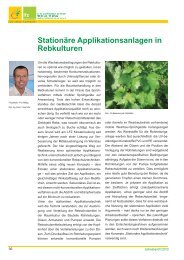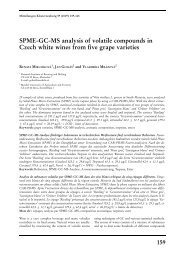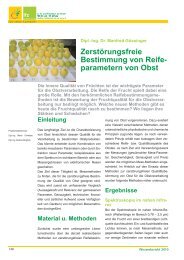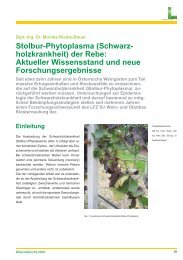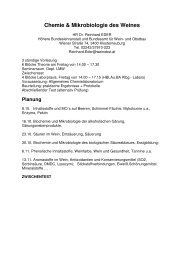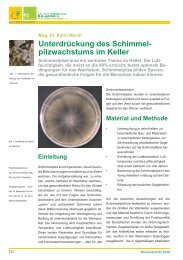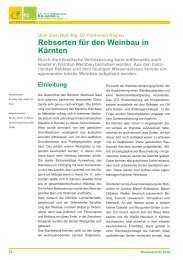Polyphenolic composition of German white wines and its use for the ...
Polyphenolic composition of German white wines and its use for the ...
Polyphenolic composition of German white wines and its use for the ...
You also want an ePaper? Increase the reach of your titles
YUMPU automatically turns print PDFs into web optimized ePapers that Google loves.
Mitteilungen Klosterneuburg 57 (2007): 146-152 Pour Nikfardjam et al.<br />
Cette <strong>composition</strong> est <strong>for</strong>tement deÂpendante du ceÂpage utilise et du mode de production.Le tyrosol dominait dans<br />
'Bacchus', 'MuÈ ller-Thurgau' et 'Silvaner', pour le 'Roter Traminer' c'eÂtait l'acide p-coumarique et pour le 'Rieslaner'<br />
l'acide 3-hydroxy-benzoyÂque.Il est vrai que les interdeÂpendances des polypheÂnols ont pu eÃtre expliqueÂes aÁ 75%au<br />
moyen de l'analyse en composantes principales, en utilisant les trois premieÁres composantes principales, mais cela ne<br />
permet pas de faire une deÂclaration deÂfinitive relative aÁ l'appartenance d'un ceÂpage sur la base de son pr<strong>of</strong>il polypheÂnolique.Le<br />
rapport entre l'acide caftarique et l'acide coutarique variait entre 0,5 et 10,6.Il ne peut cependant pas<br />
eÃtre utilise pour une distinction taxonomique des ceÂpages, eÂtant donne que la deÂpendance des facteurs non-geÂneÂtiques<br />
est trop gr<strong>and</strong>e.Il n'a eÂgalement pas eÂte possible de confirmer le rapport entre ces deux substances de 12,2 (+<br />
1,9), trouve par quelques auteurs dans les vins 'Riesling' de la reÂgion allem<strong>and</strong>e «Rheingau».Dans nos propres analyses,<br />
nous avons trouve un rapport beaucoup plus bas (8,3) et la deÂviation st<strong>and</strong>ard de + 4,1 eÂtait largement plus<br />
importante.Ici, les influences únologiques sont probablement trop <strong>for</strong>tes pour que le rapport de deux polypheÂnols<br />
diffeÂrents puisse se conserver au-delaÁ du processus de vinification.<br />
Mots cleÂs : Vitis vinifera, polypheÂnols, vin blanc, analyse en composantes principales, classification, HPLC<br />
A reliable method <strong>for</strong> <strong>the</strong> determination <strong>of</strong> <strong>the</strong> varietal<br />
origin <strong>of</strong> <strong>wines</strong> is <strong>of</strong> great interest to both wine industry<br />
<strong>and</strong> consumer. The individual polyphenolic fingerprint<br />
as reflected in <strong>the</strong> <strong>composition</strong> <strong>of</strong> hydroxycinnamic<br />
<strong>and</strong> hydroxybenzoic acids, as well as flavonoids <strong>and</strong><br />
<strong>the</strong>ir derivatives, is distinctive <strong>for</strong> any plant. For red<br />
cultivars <strong>the</strong> analysis <strong>of</strong> <strong>the</strong> anthocyanin <strong>composition</strong><br />
<strong>and</strong> <strong>the</strong> content <strong>of</strong> shikimic acid have been mainly<br />
<strong>use</strong>d <strong>for</strong> distinguishing among red grape cultivars.<br />
Commonly, HPLC methods are <strong>use</strong>d to analyse this<br />
part <strong>of</strong> <strong>the</strong> phenolic fingerprint. They have been successfully<br />
<strong>use</strong>d in <strong>German</strong>y <strong>for</strong> <strong>the</strong> au<strong>the</strong>nticity control<br />
<strong>of</strong> 'Pinot noir' <strong>wines</strong> (EDER at al., 1994; HOLBACH et<br />
al., 1997; HOLBACH et al., 1998; EDER <strong>and</strong> HOLBACH,<br />
1998). Although <strong>the</strong> polyphenolic <strong>composition</strong> <strong>of</strong> wine<br />
may be influenced by different factors such as varietal<br />
(VRHOVSEK et al., 1997) <strong>and</strong> viticultural influence<br />
(OTREBA et al., 2006), vinification, maturation <strong>and</strong><br />
aging, <strong>the</strong> differences in <strong>the</strong> overall phenolic fingerprints<br />
might still be characteristic <strong>for</strong> each cultivar.<br />
Even in very old <strong>white</strong> <strong>wines</strong>, polyphenols can be detected<br />
as was shown <strong>for</strong> 'Riesling' <strong>wines</strong> from vintages<br />
1892 to 1921 (DIETRICH et al., 2004). In fact, in earlier<br />
studies HPLC methods have already been <strong>use</strong>d <strong>for</strong> <strong>the</strong><br />
identification <strong>of</strong> <strong>white</strong> grape cultivars. RITTER et al.<br />
(1994) showed that 'Riesling' <strong>wines</strong> from <strong>the</strong> <strong>German</strong><br />
Rheingau region have a distinctive ratio <strong>of</strong> 12.2 (+<br />
1.9) <strong>for</strong> <strong>the</strong> two polyphenols caftaric <strong>and</strong> coutaric acid.<br />
PRESA-OWENS et al. (1995) found a similar ratio <strong>for</strong> <strong>the</strong>se<br />
two compounds in Spanish <strong>white</strong> <strong>wines</strong> from <strong>the</strong> Penedes<br />
region. They also showed that principal component<br />
analysis (PCA) <strong>of</strong> <strong>the</strong> polyphenolic fraction achieved a<br />
separation according to cultivar. In more recent studies<br />
polyphenolic fingerprints have been <strong>use</strong>d to identify<br />
<strong>the</strong> vintage, geographic <strong>and</strong> even winery origin <strong>of</strong> red<br />
<strong>and</strong> <strong>white</strong> <strong>wines</strong> (POUR NIKFARDJAM et al., 2006; PENÄ A-<br />
NEIRA et al., 2000; TINTTUNEN <strong>and</strong> LEHTONEN, 2001; DE<br />
VILLIERS et al., 2005). The current knowledge on <strong>the</strong><br />
presence <strong>of</strong> phenolic compounds in wine can be found<br />
in <strong>the</strong> review <strong>of</strong> MONAGAS et al. (2005).<br />
From our point <strong>of</strong> view it was interesting to see if various<br />
winemaking practices have a significant effect on<br />
<strong>the</strong> polyphenolic <strong>composition</strong> <strong>of</strong> <strong>German</strong> <strong>white</strong> wine.<br />
Importantly, we wanted to observe if <strong>the</strong> ratio <strong>of</strong> certain<br />
compounds remains constant regardless to winemaking<br />
practice <strong>and</strong>, <strong>the</strong>re<strong>for</strong>e, can be <strong>use</strong>d <strong>for</strong> <strong>the</strong><br />
identification <strong>of</strong> <strong>the</strong> cultivar. TREUTTER (1989), BOURSI-<br />
QUOT (1987) <strong>and</strong> RITTER et al. (1994) stated that especially<br />
<strong>the</strong> ratio <strong>of</strong> caftaric <strong>and</strong> coutaric acid in grapes is<br />
genetically controlled, which we also wanted to verify<br />
within <strong>the</strong> scope <strong>of</strong> this study. Fur<strong>the</strong>rmore, as RITTER<br />
et al. (1994) described, <strong>the</strong> ratio being dependent on<br />
'Riesling' from <strong>the</strong> Rheingau region only, we also collected<br />
samples from this region <strong>and</strong> analysed <strong>the</strong>ir polyphenolic<br />
<strong>composition</strong>.<br />
Materials <strong>and</strong> Methods<br />
Wine samples<br />
177 <strong>white</strong> <strong>wines</strong> <strong>of</strong> five different Vitis vinifera cultivars<br />
('Bacchus', 'MuÈ ller-Thurgau', 'Rieslaner', 'Silvaner',<br />
<strong>and</strong> 'Traminer') <strong>and</strong> different vinification techniques<br />
from vintages between 1989 <strong>and</strong> 1998 were collected<br />
from <strong>the</strong> Bayrische L<strong>and</strong>esanstalt fuÈ r Weinbau und<br />
Gartenbau in Ve<strong>its</strong>hoÈ chheim (<strong>German</strong>y). Seventeen<br />
'Riesling' <strong>wines</strong> from <strong>the</strong> <strong>German</strong> Rheingau region<br />
were purchased from local wineries.<br />
HPLC analysis<br />
Analysis was per<strong>for</strong>med using <strong>the</strong> method published by<br />
RECHNER et al. (1998). All samples were directly injec-<br />
147



